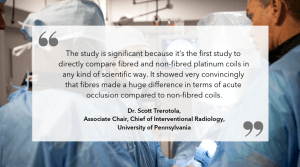 A new animal study concludes that fewer fibred embolisation coils are needed to achieve acute occlusion when compared with similar bare metal coils. The study was presented today at an industry-sponsored symposium during the 2019 annual meeting of the Society of Interventional Radiology (SIR) in Austin, Texas. Embolisation is a nonsurgical, minimally invasive procedure performed by a physician to block or reduce blood flow in arteries and veins.
A new animal study concludes that fewer fibred embolisation coils are needed to achieve acute occlusion when compared with similar bare metal coils. The study was presented today at an industry-sponsored symposium during the 2019 annual meeting of the Society of Interventional Radiology (SIR) in Austin, Texas. Embolisation is a nonsurgical, minimally invasive procedure performed by a physician to block or reduce blood flow in arteries and veins.
The animal study compared embolisation of 24 target vessels using 0.035 inch diameter platinum embolisation coils, half with fibred coils and half with non-fibred coils. Researchers concluded that the polymer fibres allow significantly fewer embolisation coils to achieve acute occlusion of arteries compared to bare metal coils. A mean of 3.2 non-fibred coils was required to achieve occlusion, while a mean of 1.3 fibred coils achieved occlusion in similarly sized arteries.
‘We were interested to see that in this blinded and randomized study, fewer fibred coils were needed to achieve occlusion’, said Mark Breedlove, vice president of the Vascular division of Cook Medical.
The study, Fibered versus non-fibered coils: comparison in a swine model, was authored by Dr Scott Trerotola, Associate Chair and Chief of Interventional Radiology at the University of Pennsylvania. Dr Trerotola and his researchers used platinum coils manufactured by Cook Medical. The coils were identical with the exception of fibre, thus reducing the variables in the study.
‘The study is significant because it’s the first study to directly compare fibred and non-fibred platinum coils in any kind of scientific way’, said Dr Trerotola. ‘It showed very convincingly that fibres made a huge difference in terms of acute occlusion compared to non-fibred coils.’
The full article will be published in the May Issue of the JVIR.
Dr Trerotola is a paid consultant of Cook Medical.
About Cook Medical
Since 1963, Cook Medical has worked closely with physicians to develop technologies that eliminate the need for open surgery. Today, we are combining medical devices, biologic materials and cellular therapies to help the world’s healthcare systems deliver better outcomes more efficiently. We have always remained family owned so that we have the freedom to focus on what we care about: patients, our employees and our communities. Find out more at cookmedical.eu and for the latest news, follow us on Twitter, Facebook and LinkedIn.